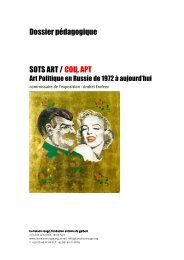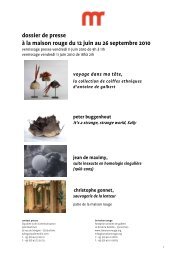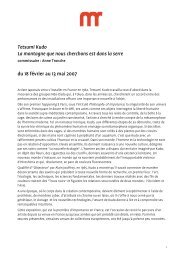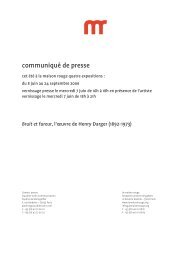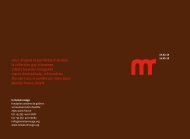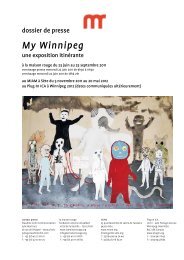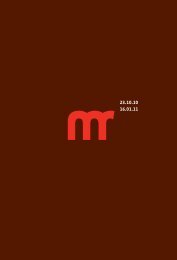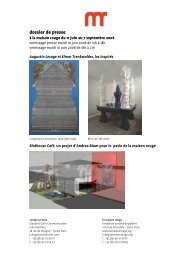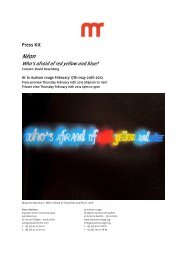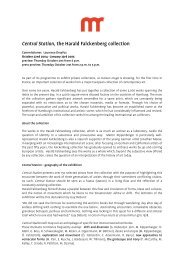Press kit JJL relu - La maison rouge
Press kit JJL relu - La maison rouge
Press kit JJL relu - La maison rouge
Create successful ePaper yourself
Turn your PDF publications into a flip-book with our unique Google optimized e-Paper software.
Would this exhibition be itself the act of putting this process into play?<br />
Yes, this exhibition is in reality a montrage (or “Show/editing” process). We know that the perception of a<br />
work and of its signifieds changes according to the context in which the work is presented. This is the big<br />
difference between the mere hanging of works [accrochage] and the complexity of a montrage: the whole is<br />
arranged in terms of the connections or caroms among the works--among their contents, not among their<br />
commercial values--and this is done in such a way as to encourage movements of thought in all senses of the<br />
term. Visible things are to make invisible ones “appear.” That is what Deleuze and Guattari called a collective<br />
arrangement of enunciation, a basic operative concept of contemporary art which, moreover, corresponds<br />
exactly to the definition of happenings as we, my friends and I, practiced them. It is a matter, therefore, of<br />
combining works that come from extremely different, even contradictory, contexts while making sure at the<br />
same time that their logic and their unique “charges” remain operative. This is where what Claude Lévi-<br />
Strauss called mythical thought comes in, that is to say, a quality of thinking that has nothing to do with<br />
rationalistic reason or with commercial imperatives. Such thinking emanates from the content of the art<br />
object while restoring its valence and respecting its modus operandi. This “crazy ambition” comes to me from<br />
André Breton: one tries to compose a signifying whole from disparate art objects and life experiences. This is<br />
quite a job in itself, and it swims against the current of the dominant trends and ideologies. I do not hesitate<br />
to construct montrages for and with works that in principle (if one sticks to the logic of capitalism alone) have<br />
no business being together but which in fact, in my mind, share some common issues and modes of<br />
operation that serve to intensify one another! What is then offered to the viewer are real possibilities of<br />
intellection, and this viewer is treated not as some kind of consumeristic dummy but rather as a person who is<br />
capable of perceiving and of conceiving these wholes as an active subject. The viewer is included in the<br />
process, as Marcel Duchamp did with Étant donnés or Giorgione with the Tempest (which, in my opinion, is<br />
one of the first pictures to have indicated to the viewer his/her place in the setup). In my work, the viewer is<br />
strategically active in the process. S/he changes status: from voyeur, s/he becomes seer; from object, s/he<br />
becomes subject, that is to say, “co-operator.”<br />
There are, therefore, encounters with people and collections of objects that accompany this process of<br />
meditation?<br />
Under the direct and decisive influence of Breton, my approach is indeed that of an anthropological<br />
researcher. It involves an attitude that feeds upon friendship, exchanges, chance encounters, and the work<br />
of a lifetime.<br />
This was decided for me very early on. I had the lucky privilege to hang out in my youth with Breton,<br />
Benjamin Péret, Duchamp, Man Ray, Henri Michaux, Allen Ginsberg, William S. Burroughs, Glissant, Paule<br />
Thévenin, Joyce Mansour, Deleuze, Guattari, Christian <strong>La</strong>gant (Noir et Rouge), Kostas Axelos and Edgar<br />
Morin (Arguments), Cornelius Castoriadis (Socialisme ou Barbarie), Eric Dolphy, Ornette Coleman, Linton<br />
Kwesi Johnson, Jacqueline Cahen, and, of course, Erró, my brother by adoption. The meaning of human<br />
existence has been radically redefined by my encounters. Those people transmitted to me the libertarian<br />
virus, which consists in not considering as adequate, or even acceptable, the substance of the dominant<br />
Europeocentrist and commercial culture. I proceed, therefore, not as a speculator-collector but as an<br />
ethnologist who searches for and gathers things here and there while wandering around as I choose on my<br />
voyages into societies that are foreign to me (and ALL of them are foreign to me, the most foreign or<br />
strange and absurd being, in my view, capitalist society): Duchampian “sex objects [objets dards],” obscure<br />
fetish-worship objects, pious images of forgotten or future religions, “natural phenomena,” traces of<br />
revolt and resistance, signposts covered with vegetation or lost in the sands, therefore unreadable or<br />
nearly so, tokens of friendship, trades, love letters, and logbooks.<br />
14



